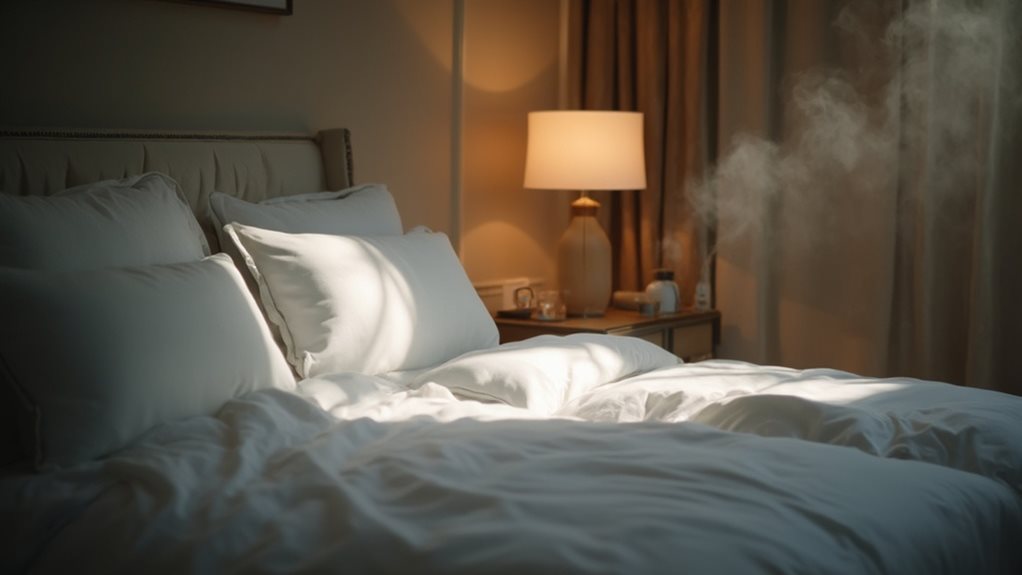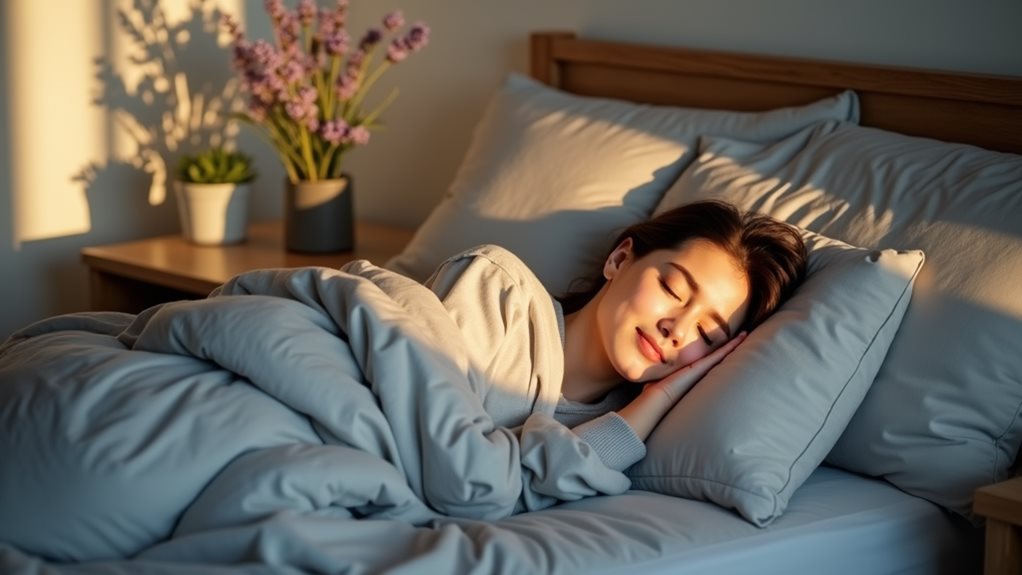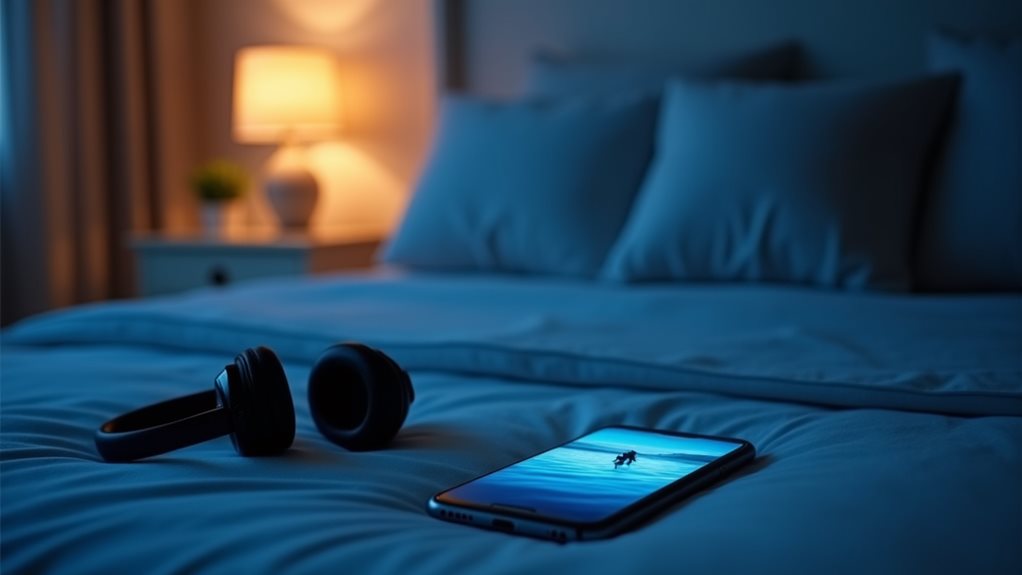
Hypnosis techniques like progressive muscle relaxation and guided imagery offer effective methods to access deep sleep. These practices, which include calming mental exercises like visualization and self-hypnosis affirmations, help diminish stress and prepare the mind and body for rest. Engaging in these techniques regularly before bedtime can greatly improve sleep quality and duration, fostering a restful and restorative nighttime experience. Exploring these strategies further may reveal additional benefits tailored to individual sleep needs.
Key Takeaways
- Utilize sleep affirmations to reinforce positive sleep beliefs and reduce bedtime anxiety.
- Engage in guided relaxation exercises to ease the mind into sleep readiness.
- Practice mental rehearsal to visualize and prepare for the sleep process, enhancing sleep onset.
- Listen to guided relaxation audio that incorporates hypnosis techniques to deepen relaxation and promote sleep.
- Integrate visualization of peaceful scenes to calm the mind and associate these visuals with sleep readiness.
Exploring the Power of Progressive Muscle Relaxation
Progressive Muscle Relaxation (PMR) is a methodically effective technique that involves the sequential tensing and relaxing of different muscle groups throughout the body.
This practice enhances muscle awareness and serves as a foundational relaxation technique. By deliberately contracting and then releasing muscles, individuals can identify areas of tension often overlooked in daily life.
PMR facilitates a deeper understanding of physical sensations and encourages a relaxation response throughout the body.
Regular application of PMR not only decreases stress but also improves physiological functions such as reducing heart rate and lowering blood pressure, which are essential for achieving restorative sleep.
The Role of Visualization and Guided Imagery in Sleep
While many sleep-enhancement techniques focus on physical relaxation, the role of visualization and guided imagery in sleep explores the mental landscape to induce tranquility.
Visualization benefits include significant reduction in stress and anxiety, fostering a mental environment conducive to rest.
Through guided imagery techniques, individuals can create and control soothing scenarios, engaging multiple senses to deepen the relaxation experience.
This process not only quiets the mind but also prepares the body for deep sleep by simulating real-life tranquility.
Regular practice of these techniques can improve overall sleep quality, making them essential tools for those seeking restorative sleep.
Mastering Self-Hypnosis for Better Sleep Patterns

How can one harness the power of self-hypnosis to improve sleep patterns? Self-hypnosis techniques offer a strategic approach to achieving deeper, more rejuvenating sleep. By utilizing sleep affirmations and guided relaxation exercises, individuals can effectively train their minds to enter a state conducive to rest. The process involves repeating calming phrases and engaging in specific mental exercises to induce relaxation.
| Technique | Description | Outcome |
|---|---|---|
| Sleep Affirmations | Repeating positive sleep statements | Reduces mental clutter |
| Guided Relaxation | Following a set relaxation script | Induces sleep readiness |
| Mental Rehearsal | Visualizing sleep process | Enhances sleep quality |
Through these methods, self-hypnosis fosters a restful environment for the mind and body.
The Benefits of Visualizing Peaceful Scenes at Bedtime
Building on the foundation of self-hypnosis for improved sleep, visualizing peaceful scenes at bedtime can further enhance the quality of rest.
Integrating peaceful imagery into one's bedtime routine engages the mind in a calming practice, shifting focus away from daily stresses. This method involves selecting serene visuals that resonate on a personal level and focusing on the sensory details of these scenes.
Research supports that such visualization promotes a relaxation response, reducing the time it takes to fall asleep. Regularly participating in this practice helps condition the mind to associate these calming images with sleep, thereby fostering a more restful night.
Integrating Guided Relaxation Audio Into Your Nightly Routine

Integrating guided relaxation audio into your nightly routine can greatly enhance the effectiveness of hypnosis techniques for better sleep.
These audios often include elements of guided meditation, specifically designed to activate sleep triggers through calming narratives and soothing sounds. Clinical studies suggest that such auditory stimuli not only facilitate the shift into sleep but also improve sleep quality by deepening the relaxation state.
Incorporating these audios systematically each night establishes a psychological cue, signaling to the brain that it is time to wind down. This practice, when consistently applied, can markedly contribute to a more structured and restorative sleep cycle.
Frequently Asked Questions
How Quickly Can Hypnosis Techniques Improve Sleep Quality?
The sleep improvement timeline varies with hypnosis techniques. Research indicates effectiveness depends on individual receptivity and regular practice. Some may notice changes within days, while others may require weeks to observe significant sleep quality enhancements.
Are Hypnosis Techniques Safe for Children and Elderly?
Hypnosis techniques, balancing child safety and elderly considerations, generally offer a non-invasive approach. These methods are clinically recognized for enhancing sleep without significant risks, making them suitable for varied age groups under proper guidance.
Can Hypnosis Replace Sleep Medication?
Hypnosis may serve as an alternative to sleep medication for some individuals, offering a non-pharmaceutical option to enhance sleep quality. However, effectiveness varies, and it should be considered alongside professional medical advice.
How to Choose the Right Guided Relaxation Audio?
To select the right guided relaxation audio, one should consider their audio preferences and relaxation styles. For instance, a person favoring nature sounds might choose audios featuring ocean waves or forest ambience.
What Are the Long-Term Benefits of Self-Hypnosis for Sleep?
Long-term benefits of self-hypnosis for sleep include significant improvements in sleep quality and duration. Techniques foster relaxation, reduce anxiety, and establish healthier sleep patterns, contributing to overall mental and physical well-being.
Conclusion
In summary, hypnosis serves as a key to accessing the sanctuary of restorative sleep, akin to finding a calm port in the stormy seas of daily stress. By employing techniques such as progressive muscle relaxation, visualization, and guided imagery, individuals can effectively quiet the mind and prepare the body for rest. Incorporating these practices into bedtime rituals not only fosters deeper sleep but also greatly enhances overall well-being, demonstrating that a well-rested mind is truly a well-equipped mind.





